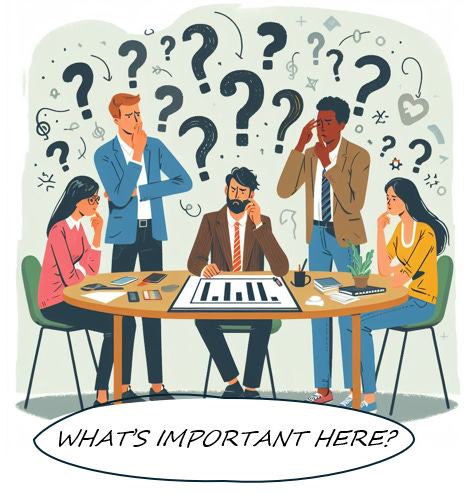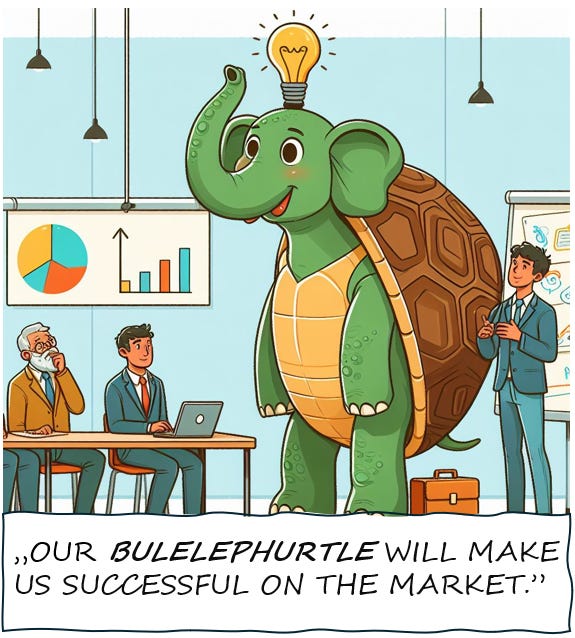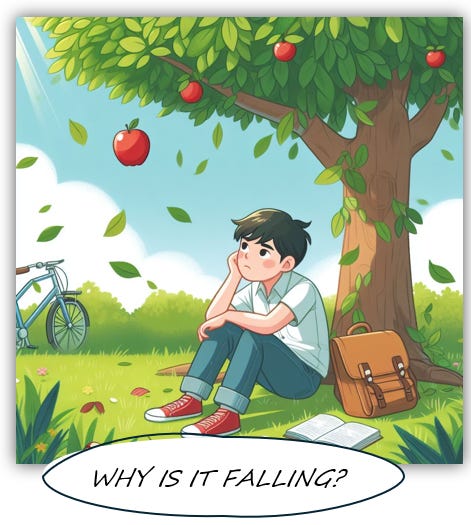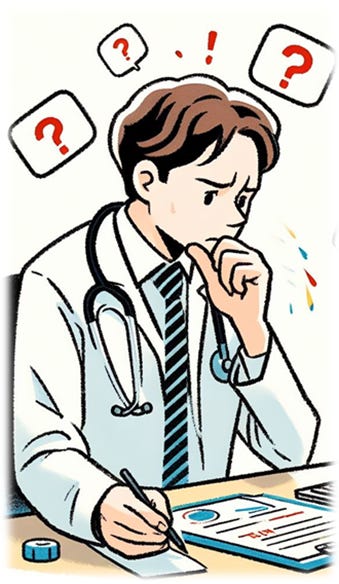What is the real problem here?
Art of deciding what's important.
“If I had an hour to solve a problem, I'd spend 55 minutes thinking about the problem and 5 minutes thinking about solutions."
Although there's ongoing debate about whether Einstein actually authored this quote, its message strongly emphasizes the crucial role of diagnosis in the strategy crafting process. It’s the place where you start - you cannot work on something unless you first try to set some frames around the challenges you are trying to solve.
Yet, we very often stop and ask ourselves whether a problem we are working on is worth solving or even whether such a problem really exists (picture thousands of startups doing things nobody cares about).
A proper diagnosis ensures that all subsequent efforts are meaningful and directed effectively. As Caterina Fake pointed out, "So often people are working hard at the wrong thing. Working on the right thing is probably more important than working hard.
A friend’s aunt, in the aftermath of COVID, began experiencing severe chest pain. Seeking medical help, she encountered a doctor who, influenced by the prevalent lung issues of that time, diagnosed her condition as a pulmonary problem. An X-ray showed minor changes, leading to a prescription of rest. However, the pain persisted, and only later was it discovered to be cancer metastases in an advanced stage. Tragically, she passed away six months later due to this initial misdiagnosis.
This story painfully illustrates that the impact of addressing the wrong problem and maybe the consequences may not always be that brutal, but they always exist (even lost time that no one will give back).
Therefore, before we start working on any strategy and engage in brainstorming, we should spend some time defining the problem we want to work on. Your problem must undergo detailed research to be sure that the solutions developed will lead to the desired outcomes.
Unfortunately as you read this, there are thousands (if not millions) of activities across the globe aiming to achieve specific outcomes, yet addressing the incorrect problems.
It’s a common occurrence and there are several understandable reasons behind this:
We don’t spend enough time on it or the time we spend is “bad”:
Thinking is really hard. And I really mean it. It’s hard to stop, capture the big picture, and analyze the different forces at play. You need to harness a lot of mental energy to break down a given topic into individual parts, think about how they are intertwined, and whether each of them is equally important. As humans, we prefer to do longer work that won't be a big mental effort for us, rather than spending a few hours where our minds may get hot from thinking. That’s why we move such tasks to the end of our TODO list and focus on keeping the lights on with our work.
Another important thing is that as human beings, we also want to jump directly to the solution, which usually means pursuing the very first option that comes to mind and acting on it. Take your time. Generate at least a few ideas about what’s important in this problem. If you’re planning to do any workshop - separate them: one to define the problem, a second to think about possible solutions.
You also need to be in the right mode - don't fool yourself into thinking that if you are knee-deep in operational activities, by squeezing an hour between different project tasks, you will be able to switch to big-picture thinking. You need to be well-rested, and your mind shouldn't be preoccupied with how to organize the next stages of your projects. I know - it's easier said than done, but if you're going to spend a 'bad time' on it, sometimes it's better to let it go.
I'm a big proponent of booking such a workshop in advance and for the whole day/week (depending on the challenges you’re going to work on) to ensure your time won’t be interrupted by other things. Another place, different from where you do your day-to-day work, also works really well.
We didn’t have the competencies or knowledge to know what’s important in this particular case
The first time I encountered design thinking, I felt like I had found the golden fleece. Here's a process that can solve any problem on Earth. You just need to figure out what the problem is (research user needs), then have a brainstorming session where you absolutely should not limit yourself, let your imagination run wild, and finally, build a prototype and test whether the solution works in practice.
What could be simpler?
As it turned out, coming up with practical solutions is not as easy as it was during our design thinking training. Moreover, when defining the very topic of the workshop, we face the first significant problems (and I say this from the perspective of a participant in many workshops, which, in reality, should never have taken place).
If you don’t know the constraints or the broader context of the things you are brainstorming about, you will work on irrelevant issues and/or generate ideas that are disconnected from reality.
Let's say you work in the pharmaceutical business and your competition is starting to gain a bigger market share thanks to their innovations. If you don't know anything about this market - like who the competitors are, how drugs are made, what's important for your market segment, or what the certification restrictions are - then your ideas might look great on paper (sort of “Hey, let’s make a pill that will cure all illnesses all over the world”), but in reality, they won't help you move forward.
Having one person of that sort during a brainstorming session can indeed be useful, but if we have five people creating a market strategy and none of them have worked in the market or know the customers' needs, a red flag should go up.
If an apple had fallen on somebody else’s head instead of Newton’s, would he have come up with the same theory? Probably not. He would have eaten the apple without giving too much thought to why it happened. However, since he possessed certain knowledge, he could ask himself questions like how what he sees can be explained through the theories he knows.
You need to have a certain understanding within the required area to be able to diagnose the problem. Otherwise, you may assume that the challenge you’re working on is important while it won’t lead to the required outcomes, or what’s worse, it may not matter at all.
We don’t want to accept what is important:
The first principle is that you must not fool yourself, and you are the easiest person to fool.
I like this quote from Richard Feynman as it captures a part of human nature. People may have access to the perfect set of data and still manage to ignore it. We hunt for information that confirms our initial assumptions (often self-serving) instead of trying to find out where the truth is.
Sometimes we even know where the problem is (we feel it under our skin), but we don’t want to accept it. We say, “our product is very good; it’s our sales department that needs to be changed. They don’t know how to sell!” When, despite many changes in this area, there's no movement in sales numbers, we look for remedial plans in other departments of the company (“it’s definitely problem with marketing, they have no idea how to promote it”). At the same time, we push away the thought that perhaps it is our product that is poor and non-competitive compared to other companies.
Sometimes the diagnosis says more about the diagnostician than the patient, as they say.
Then, there's an even harder level. The internal narratives of some people in the organization (which, of course, don’t see the light of day because they can't be acknowledged) may go something like this:
“If everyone changes, maybe I can stay the same, and I won't have to struggle.”
This kind of approach is very difficult to detect. Firstly, it is not (and cannot be) officially communicated; secondly, it is intentionally 'masked or hidden' by certain individuals. They deliberately introduce problematic concepts, pointing out their significance while selectively using data or isolated events that don't happen often or are irrelevant. The goal is to redirect attention to another area so that they do not have to change anything on their part (inner voice says “let’s maintain the status quo”).
You'd be surprised how often this happens - especially if such a person is high up in the organizational structure or has good storytelling skills.
How do I know that I have correctly diagnosed my problem or challenge?
First off, once you have completed your diagnosis, ask yourself:
'By resolving this issue, what result do I expect?'
Be specific. If you anticipate an increase in sales revenue, define how much. For some, this may mean a 5% increase, while for others, it could be as much as 40%. Also, determine when this will happen and set specific milestones for achieving your goal. If you're aiming for a 40% increase in your annual revenue, certain steps need to be taken beforehand to achieve this (after all, you can't expect to make up for an 11-month gap in the final month of the year).
Secondly, set a tripwire. Choose a moment in time to revisit your diagnosis and assess its accuracy. You hoped to increase your sales by 10% within a month; did that happen? If not, it's back to the drawing board to analyze again - was the diagnosis incorrect, or was the solution not implemented effectively?
Furthermore, consider the potential consequences of your actions. Sometimes, solving one problem can create others, potentially more serious. You might achieve your sales targets by pushing your company to the limit this year, but at the cost of losing key employees and diminishing product quality.
While you may solve the issue in the short term, in the long run, it could pose a greater risk.
Remember, a correct diagnosis is key to effective treatment. Without a clear understanding of what you are addressing, you are essentially walking in the dark. It's the foundation and starting point of all strategic work. If done improperly, you risk not only wasting your efforts but also potentially creating more and worse problems.
Don't ignore this part and devote sufficient (good) time to it!






